The alien abduction scenario feels a little over the top to me but I think your example of teaching people to shoplift as a way to help them learn to prevent shoplifting is a fabulous idea!
I did something similar once in a course for teachers and parents on preventing cyberbullying. The learners were introduced to the features/typical use of each technology and asked to anticipate how they might be used in a negative way – to bully someone.
How Are Alien Abductions Related to Effective E-Learning?
June 17th, 2014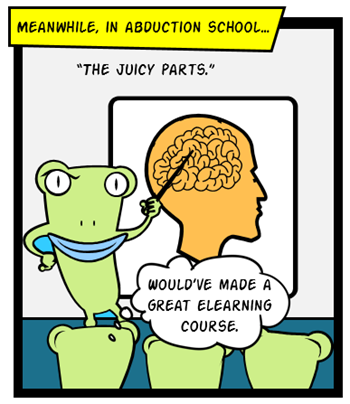
You’re the site safety manager and arrive at company headquarters to find the workplace in disarray. Tables are knocked over, the place is littered with documents, and your cubicle is covered in slime. And you can’t find anyone in the building.
Footage from the security cameras reveal that the site’s been overrun by aliens and all of the staff has been abducted. What do you do? How does the company’s disaster recovery plan handle alien abductions?
Create a Flipped Perspective
Goofy scenario? Perhaps. But here’s something to consider. Course content that is too close to the learner’s world may hamper the learning experience. Sometimes it makes sense to use a flipped perspective and create something novel that puts the learner in a situation different than the world in which they reside?
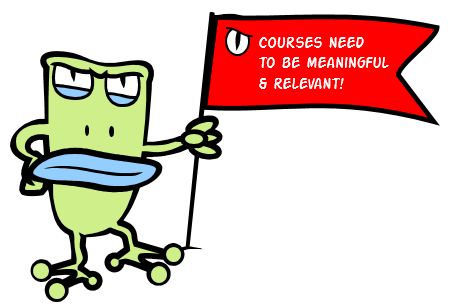
It’s important that the courses we build are relevant and meaningful. Often I’ll use real-world content to build out interactive scenarios. However, there are times when people get so caught up in the real-world training content that they lose sight of the course objectives. For example, I used to have a fake CPR demo to teach some software features and production tips. But every time I’d show the demo, I’d get complaints about the content in the CPR training (even after I said it’s just filler content and not a real course).
The objective wasn’t to teach CPR. That was just content I could use to teach course design. But because the CPR content was so similar to what they already knew, it interfered with the learning process.
And that’s the key point: if the situational content is too close to the real-world they may not be able to see past the content and focus on the real learning objectives. A flipped perspective gets the learner away from the details of their day-to-day routines. They aren’t distracted by those things they know and you can get them focused on learning what it is they need to know.
Tips on Flipped Perspective
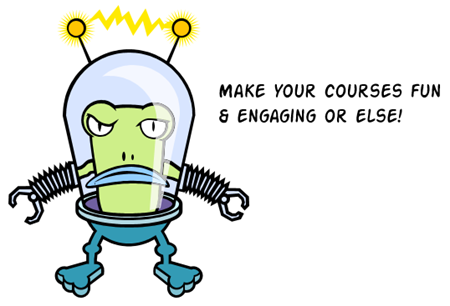
If you do change the content around, here are a few basic considerations:
- Changing perspective exposes different opportunities. We tend to be myopic so seeing things from a different angle helps us move past our routines or presuppositions. This opens the doors to creative approaches we may not have considered with real-world content.
- Make sure the tasks are relevant. The content or environment may be flipped, but the application of the learning should still be relevant and transferrable to what they need to do in real life. In the example above, alien abduction is a form of disaster, but the process for responding to a disaster is the same whether abduction, earthquake, or hurricane.
- Create a clear way to assess their mastery of the desired skills and their level of understanding. Again, be clear about the learning objectives so that they are the focal point and you can measure them effectively.
- Add a humorous or interesting perspective to the activities. In some of my workshops we train people how to shoplift as an approach to designing a course on how to prevent shoplifting. A novel approach like this allows for fun activities and great discussion. All of that makes the learning experience engaging. It’s also a way to get some nice watches from the local stores.
Alien abductions may not happen (or maybe they do); but if they did the process for disaster recovery is probably similar to that of other incidents. But what makes the abduction narrative work is that it’s different and forces the learner to think through the same content in a slightly different way.
So in your next course, look for ways to flip the perspective. Find a way to put the learning content in a world that’s different than the learners’. This gets them to think through the same tasks in a new way.
Events
- Everyday. Check out the weekly training webinars to learn more about Rise, Storyline, and instructional design.
Free E-Learning Resources
 |
 |
 |
|
Want to learn more? Check out these articles and free resources in the community. |
Here’s a great job board for e-learning, instructional design, and training jobs |
Participate in the weekly e-learning challenges to sharpen your skills |
 |
 |
 |
|
Get your free PowerPoint templates and free graphics & stock images. |
Lots of cool e-learning examples to check out and find inspiration. |
Getting Started? This e-learning 101 series and the free e-books will help. |
3 responses to “How Are Alien Abductions Related to Effective E-Learning?”
Love this post!
Could you also please post the anti-shoplifting demo? I need a new watch (hahahahahah)!
I’ve run into this frequently. I frequently teach supervisors how to design a training plan, and as soon as I mention any piece of equipment (as an example of something they might have to train people on), they get lost – either they don’t have that piece of equipment, or they focus on the details of operating that equipment and lose the overall message. So I created the “Glaknor” a piece of equipment that does absolutely everything, manufacturers all types of products, packaging, warehousing, you name it. It worked even better than anticipated as it put my trainees more in the position of their trainees, working with something where they don’t know what they don’t know.


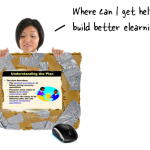
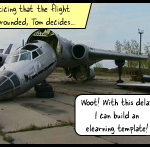

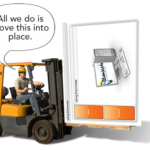



0
comments